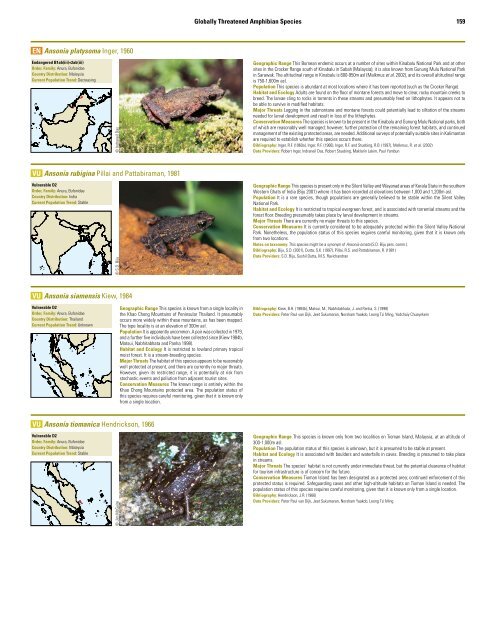Globally Threatened Amphibian Species Part 1
Globally Threatened Amphibian Species Part 1
Globally Threatened Amphibian Species Part 1
You also want an ePaper? Increase the reach of your titles
YUMPU automatically turns print PDFs into web optimized ePapers that Google loves.
<strong>Globally</strong> <strong>Threatened</strong> <strong>Amphibian</strong> <strong>Species</strong> 159<br />
EN Ansonia platysoma Inger, 1960<br />
Endangered B1ab(iii)+2ab(iii)<br />
Order, Family: Anura, Bufonidae<br />
Country Distribution: Malaysia<br />
Current Population Trend: Decreasing<br />
© Indraneil Das<br />
Geographic Range This Bornean endemic occurs at a number of sites within Kinabalu National Park and at other<br />
sites in the Crocker Range south of Kinabalu in Sabah (Malaysia); it is also known from Gunung Mulu National Park<br />
in Sarawak. The altitudinal range in Kinabalu is 600-950m asl (Malkmus et al. 2002), and its overall altitudinal range<br />
is 750-1,600m asl.<br />
Population This species is abundant at most locations where it has been reported (such as the Crocker Range).<br />
Habitat and Ecology Adults are found on the floor of montane forests and move to clear, rocky mountain creeks to<br />
breed. The larvae cling to rocks in torrents in these streams and presumably feed on lithophytes. It appears not to<br />
be able to survive in modified habitats.<br />
Major Threats Logging in the submontane and montane forests could potentially lead to siltation of the streams<br />
needed for larval development and result in loss of the lithophytes.<br />
Conservation Measures The species is known to be present in the Kinabalu and Gunung Mulu National parks, both<br />
of which are reasonably well managed; however, further protection of the remaining forest habitats, and continued<br />
management of the existing protected areas, are needed. Additional surveys of potentially suitable sites in Kalimantan<br />
are required to establish whether this species occurs there.<br />
Bibliography: Inger, R.F. (1960a), Inger, R.F. (1966), Inger, R.F. and Stuebing, R.B. (1997), Malkmus, R. et al. (2002)<br />
Data Providers: Robert Inger, Indraneil Das, Robert Stuebing, Maklarin Lakim, Paul Yambun<br />
VU Ansonia rubigina Pillai and Pattabiraman, 1981<br />
Vulnerable D2<br />
Order, Family: Anura, Bufonidae<br />
Country Distribution: India<br />
Current Population Trend: Stable<br />
© S.D. Biju<br />
Geographic Range This species is present only in the Silent Valley and Wayanad areas of Kerala State in the southern<br />
Western Ghats of India (Biju 2001) where it has been recorded at elevations between 1,000 and 1,200m asl.<br />
Population It is a rare species, though populations are generally believed to be stable within the Silent Valley<br />
National Park.<br />
Habitat and Ecology It is restricted to tropical evergreen forest, and is associated with torrential streams and the<br />
forest fl oor. Breeding presumably takes place by larval development in streams.<br />
Major Threats There are currently no major threats to this species.<br />
Conservation Measures It is currently considered to be adequately protected within the Silent Valley National<br />
Park. Nonetheless, the population status of this species requires careful monitoring, given that it is known only<br />
from two locations.<br />
Notes on taxonomy: This species might be a synonym of Ansonia ornata (S.D. Biju pers. comm.).<br />
Bibliography: Biju, S.D. (2001), Dutta, S.K. (1997), Pillai, R.S. and Pattabiraman, R. (1981)<br />
Data Providers: S.D. Biju, Sushil Dutta, M.S. Ravichandran<br />
VU Ansonia siamensis Kiew, 1984<br />
Vulnerable D2<br />
Order, Family: Anura, Bufonidae<br />
Country Distribution: Thailand<br />
Current Population Trend: Unknown<br />
Geographic Range This species is known from a single locality in<br />
the Khao Chong Mountains of Peninsular Thailand. It presumably<br />
occurs more widely within these mountains, as has been mapped.<br />
The type locality is at an elevation of 300m asl.<br />
Population It is apparently uncommon. A pair was collected in 1979,<br />
and a further five individuals have been collected since (Kiew 1984b,<br />
Matsui, Nabhitabhata and Panha 1998).<br />
Habitat and Ecology It is restricted to lowland primary tropical<br />
moist forest. It is a stream-breeding species.<br />
Major Threats The habitat of this species appears to be reasonably<br />
well protected at present, and there are currently no major threats.<br />
However, given its restricted range, it is potentially at risk from<br />
stochastic events and pollution from adjacent tourist sites.<br />
Conservation Measures The known range is entirely within the<br />
Khao Chong Mountains protected area. The population status of<br />
this species requires careful monitoring, given that it is known only<br />
from a single location.<br />
Bibliography: Kiew, B.H. (1984b), Matsui, M., Nabhitabhata, J. and Panha, S. (1998)<br />
Data Providers: Peter Paul van Dijk, Jeet Sukumaran, Norsham Yaakob, Leong Tzi Ming, Yodchaiy Chuaynkern<br />
VU Ansonia tiomanica Hendrickson, 1966<br />
Vulnerable D2<br />
Order, Family: Anura, Bufonidae<br />
Country Distribution: Malaysia<br />
Current Population Trend: Stable<br />
© Jim McGuire<br />
Geographic Range This species is known only from two localities on Tioman Island, Malaysia, at an altitude of<br />
300-1,000m asl.<br />
Population The population status of this species is unknown, but it is presumed to be stable at present.<br />
Habitat and Ecology It is associated with boulders and waterfalls in caves. Breeding is presumed to take place<br />
in streams.<br />
Major Threats The species’ habitat is not currently under immediate threat, but the potential clearance of habitat<br />
for tourism infrastructure is of concern for the future.<br />
Conservation Measures Tioman Island has been designated as a protected area; continued enforcement of this<br />
protected status is required. Safeguarding caves and other high-altitude habitats on Tioman Island is needed. The<br />
population status of this species requires careful monitoring, given that it is known only from a single location.<br />
Bibliography: Hendrickson, J.R. (1966)<br />
Data Providers: Peter Paul van Dijk, Jeet Sukumaran, Norsham Yaakob, Leong Tzi Ming
















